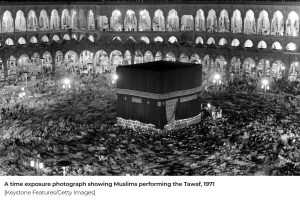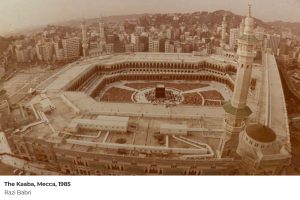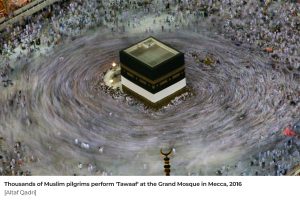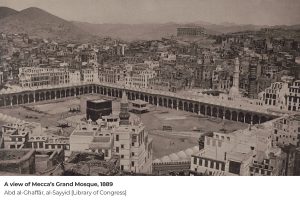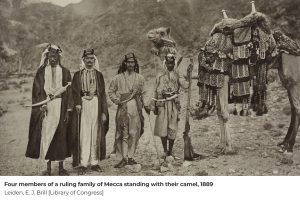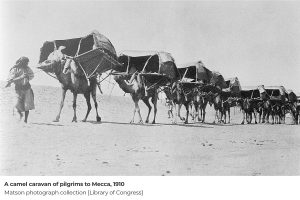As the sun rises over Mecca on Sunday July 18, up to 60,000 pilgrims dressed in customary white robes called Ihram will begin their five-day long spiritual journey to seek forgiveness for past sins and start a new chapter for the sake of Allah.
The Hajj is is one of the five pillars of Islam and a once-in-a-lifetime duty for all able-bodied Muslims to perform if they can afford it. Before the coronavirus pandemic, some 2.5 million pilgrims would descend on Mecca for the annual Hajj.
However, this year, like 2020, no foreign pilgrims will attend the Hajj after Saudi Arabia restricted the annual pilgrimage to a maximum of 60,000 vaccinated citizens and residents between the ages of 18 and 65.
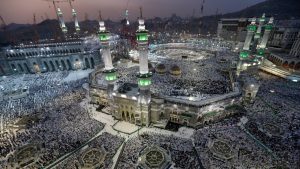
Mecca from the sky
Central to the Muslim pilgrimage is the Grand Mosque of Mecca which houses the Ka^bah, a cube-shaped structure elegantly draped in black silk with verses of the Quran woven into it with gold and silver threads.
Muslims believe that the prophet Abraham and his son, Ishmael built the Ka^bah. The structure has been built and rebuilt several times with the last major renovation taking place in 1996 to strengthen its foundation. Wherever they are in the world, Muslims face the direction of the Kaaba when performing their prayers.
To accommodate the millions of pilgrims who normally attend the annual pilgrimage, the grounds of the Grand Mosque have expanded considerably over the past few decades. In 2019, Saudi Arabia announced that it had received more than 95 million pilgrims over the past 50 years, and that it planned to host 30 million pilgrims for Hajj and Umrah each year.
Google Earth satellite images captured from 2004 through to December 2020 show just how quickly the holy city has expanded.
For Muslims, the Hajj re-enacts the actions of the Prophet Muhammad in his “farewell pilgrimage” in 632 AD which traces the footsteps of the prophets Abraham and Ishmael through the Arabian desert. It is a central pillar of the Islamic faith meant to cleanse followers of sin and bring them closer to Allah.
Hajj falls on the 8th of Dhul al-Hijjah, the twelfth and final month in the Islamic lunar calendar which shifts 10-12 days earlier each year. The pilgrimage spans five days and involves travelling to key locations around Mecca including Mina, Mount Arafat, Muzdalifah, the Jamarat and the Grand Mosque.
We take a look at the step-by-step process in the infographic below.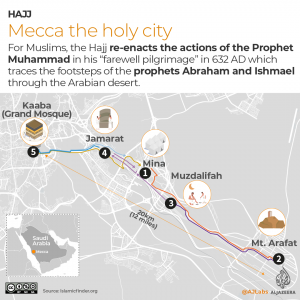
For hundreds of years pilgrims from all over the world would travel on camelback or by ship for weeks at a time to reach Mecca. With the convenience of modern air travel this journey can now be completed within hours.
Some of the iconic moments in history starting in 1889
Hajj socially distanced
At its peak in 2012, nearly 3.2 million pilgrims from over 190 countries performed the Hajj. Just one year later, an outbreak of the Middle East Respiratory Syndrome, or MERS coronavirus, forced roughly a million pilgrims to forgo the trip to Mecca.
In 2020, following the outbreak of COVID-19, Saudi officials announced that they would permit only about 10,000 pilgrims residing in the kingdom to perform the Hajj with no overseas visitors allowed.
This year, up to 60,000 vaccinated citizens and residents of Saudi Arabia between the ages of 18 and 65 will be permitted to perform the annual pilgrimage.
On March 19, 2020, Saudi authorities suspended all prayers at the two main mosques in Mecca and Medina. Congregational prayers resumed seven months later with protective measures in place. Muslim travellers from outside Saudi Arabia were permitted a limited number of Umrah visas starting on November 1, 2020.
Hajj in the digital world
For millions unable to make the pilgrimage this year, a digital experience may offer a glimpse of what it is like to worship at Islam’s holiest site. In 2015, Al Jazeera produced a 360-degree VR experience that takes viewers on a tour to see the major landmarks that millions of Muslims visit during the Hajj.
Eid al-Adha or the Feast of Sacrifice is celebrated on the third day of Hajj and lasts for three days. This year Muslims worldwide will celebrate Eid on 20-22 July. Eid al-Adha is the second major Muslim festival after Eid al-Fitr, which marks the end of Ramadan, the month of fasting.
Sunna Files Free Newsletter - اشترك في جريدتنا المجانية
Stay updated with our latest reports, news, designs, and more by subscribing to our newsletter! Delivered straight to your inbox twice a month, our newsletter keeps you in the loop with the most important updates from our website





